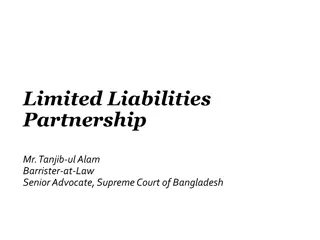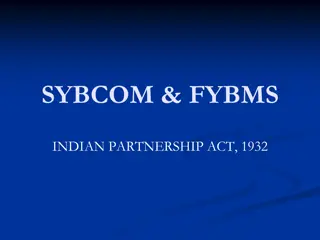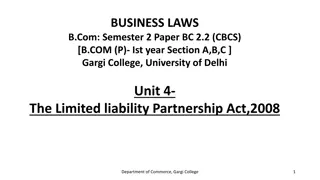Understanding the Essential Features of Partnership
Partnership is the relationship between two or more individuals who agree to share profits and losses in a business venture. Essential features include having two or more partners, a mutual agreement, conducting business activities, mutual agency among partners, sharing of profits and losses, and joint liability for partnership debts. Establishing a partnership requires a clear understanding of these key elements to foster a successful business collaboration.
Download Presentation

Please find below an Image/Link to download the presentation.
The content on the website is provided AS IS for your information and personal use only. It may not be sold, licensed, or shared on other websites without obtaining consent from the author. Download presentation by click this link. If you encounter any issues during the download, it is possible that the publisher has removed the file from their server.
E N D
Presentation Transcript
When two or more persons join hands to set up a business and share its profits and losses, they are said to be in partnership. Section 4 of the Indian Partnership Act 1932 defines partnership as the relation between persons who have agreed to share the profits of a business carried on by all or any of them acting for all . Persons who have entered into partnership with one another are individually called partners and collectively called firm . The name under which the business is carried is called the firm s name . A partnership firm has no separate legal entity, apart from the partners constituting it
The Essential features of partnership are: 1. Two or More Persons: In order to form partnership, there should be at least two persons coming together for a common goal. In other words, the minimum number of partners in a firm can be two. There is however, a limit on their maximum number. If a firm is engaged in the banking business, it can have a maximum of ten partners while in case of any other business, the maximum number of partners can be twenty. 2. Agreement: Partnership is the result of an agreement between two or more persons to do business and share its profits and losses. The agreement becomes the basis of relationship between the partners. It is not necessary that such agreement is in written form. An oral agreement is equally valid. But in order to avoid disputes, it is preferred that the partners have a written agreement.
The Essential features of partnership are: 3. Business: The agreement should be to carry on some business. Mere co- ownership of a property does not amount to partnership. For example, if Rohit and Sachin jointly purchase a plot of land, they become the joint owners of the property and not the partners. But if they are in the business of purchase and sale of land for the purpose of making profit, they will be called partners. 4. Mutual Agency: The business of a partnership concern may be carried on by all the partners or any of them acting for all. This statement has two important implications. First, every partner is entitled to participate in the conduct of the affairs of its business. Second, that there exists a relationship of mutual agency between all the partners. Each partner carrying on the business is the principal as well as the agent for all the other partners. He can bind other partners by his acts and also is bound by the acts of other partners with regard to business of the firm. Relationship of mutual agency is so important that one can say that there would be no partnership, if the element of mutual agency is absent.
The Essential features of partnership are: 5. Sharing of Profit: Another important element of partnership is that, the agreement between partners must be to share profits and losses of a business. Though the definition contained in the Partnership Act describes partnership as relation between people who agree to share the profits of a business, the sharing of loss is implied. Thus, sharing of profits and losses is important. If some persons join hands for the purpose of some charitable activity, it will not be termed as partnership. 6. Liability of Partnership: Each partner is liable jointly with all the other partners and also severally to the third party for all the acts of the firm done while he is a partner. Not only that the liability of a partner for acts of the firm is also unlimited. This implies that his private assets can also be used for paying off the firm s debts.























